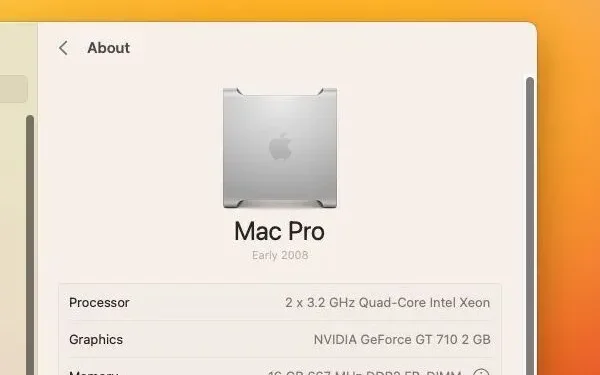Running macOS Ventura on older Macs isn’t easy, but some developers are making progress

Bypassing the official macOS system requirements to run new versions of software on older, unsupported Macs has a rich history. Tools like XPostFacto and LeopardAssist could help older PowerPC Macs run newer versions of Mac OS X, a tradition kept alive in the modern era by dosdude1 patchers for Sierra, High Sierra, Mojave, and Catalina.
For Big Sur and Monterey, OpenCore Legacy Patcher (OCLP for short) is the best way to run new versions of macOS on older Macs. It is a fork of the OpenCore Hackintosh bootloader and is updated fairly frequently with new features and fixes, as well as compatibility with newer versions of macOS. The OCLP developers have acknowledged that macOS Ventura support will be tricky, but they’ve made progress in some important areas that should make some older Macs last a little longer.
How is Ventura different?
In some years past, the hardware differences between “supported”and “unsupported”Macs could be so small that the only thing you had to do in order to boot new versions of macOS was trick the bootloader into thinking it was running on slightly more new Mac. But this approach has become more complicated as Apple removes more and more support for the Intel Mac from macOS.
OCLP and dosdude1 patchers could usually rely on some older but officially supported models to expand support for unsupported Macs with similar hardware. For example, in macOS Monterey, Apple officially ended support for a number of 2012, 2013, and 2014 Mac models that used 3rd generation (Ivy Bridge) and 4th generation (Haswell) processors. But because Monterey continued to support the 2013 Mac Pro with Ivy Bridge processor and the 2014 Mac mini with Haswell processor, the OS still retained some basic level of support for those processors (and accompanying GPU and chipset hardware), which made Monterey easier to get. works on other Macs with the same chips.
Ventura is different. It doesn’t officially support any older than 7th generation (“Kaby Lake”) Intel processors, and Apple actually did a big cleanup behind the scenes to remove drivers and other OS components that Macs with older processors relied on. This includes GPU drivers for older Intel and AMD GPUs, the latest remnants of native Nvidia GPU driver support in macOS, USB support for many older models, trackpad support without Force Touch, drivers for Intel Ethernet controllers, and more.
And the changes go deeper than the drivers. Apple also removed support for older x86 processors that do not support the AVX2 instruction set, causing the OS to not boot at all on processors without those instructions. AVX2 was introduced in Haswell processors, which adds another hurdle for those hoping to run Ventura on something older.
Apple has also changed the Metal rendering stack so that it is incompatible with Monterey-era drivers for older GPU hardware (obviously, this is completely unrelated to the Metal 3 updates; Ventura officially supports many Metal 2-only Macs). If you add the old drivers back, you will get basic display output without graphics acceleration. For a complete list of roadblocks developers need to address in order to run Ventura on unsupported Macs, check out the OpenCore Legacy Patcher Github repository.
Signs of progress
After many months of work, we are finally running macOS Ventura on legacy Metal GPUs!
This includes my early 2008 Mac Pro (Nvidia Kepler and AMD GCN 1), 2012 Mac mini, 2014 Mac mini and 2014 iMac 5k! pic.twitter.com/cMQ5Qk8uoo
This Github post is a bit pessimistic about the future of Ventura support on these older machines. “Looking at all the challenges we face, I don’t believe there are any short-term possible solutions for the community to use,” project leader Mykola Grimalyuk wrote back in June. “The optimal timeframe would be 6 months when a proper build of the OpenCore Legacy Patcher is released, but even that is hard to promise.”
But progress has been made despite this initial pessimism. First, while macOS doesn’t technically include system files for pre-AVX2 Intel processors, the Apple Rosetta 2 software still does include those files because Rosetta 2 emulates the capabilities of the pre-AVX2 x86 processor. By extracting and installing these files in Ventura, you can re-enable support on Ivy Bridge and older processors without AVX2 instructions.
And this week, Grimalyuk showed off another breakthrough: working graphics support on older Metal-enabled Macs, including old machines like the 2014 iMac 5K, the 2012 Mac mini, and even the 2008 Cheese Grater-style Mac Pro Tower.
The OCLP team still has other issues that need to be addressed, not least of which will be automating all of these hacks so that users without a deep technical understanding of macOS basics can continue to configure and use the bootloader. Grimalyuk will still not talk about the timing of Ventura’s official support in OCLP. But given the progress made so far, it seems likely that people with 2012 and newer Macs should still be able to run Ventura on their Macs without giving up graphics acceleration or other essential features.
Leave a Reply